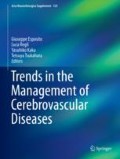Abstract
Background and aims. The superficial temporal artery to middle cerebral artery (STA-MCA) bypass procedure has continually evolved and new strategies have been advocated to reduce anesthetic or surgical mortality and morbidity. Further simplifying and decreasing the invasiveness of STA-MCA bypass by performing this operation without endotracheal general anesthesia was deemed feasible in certain subsets of patients.
Methods. We performed STA-MCA bypass using local anesthesia using a sedative in 45 patients with hemodynamically compromised cerebrovascular occlusive disease as well as multiple comorbidities in the period between February 2010 and April 2016. The technique is based on preoperative identification of the point at which the donor and recipient vessels are in closest proximity. The preoperative use of computed tomography angiography allowed us to identify the target point precisely and use a minimally invasive procedure. All patients received dexmedetomidine as the sole sedative agent, together with scalp block local anesthesia with an unsecured airway.
Results. Successful STA-MCA bypass surgeries were achieved via a preselected minimally invasive approach in all cases. There was good hemodynamic stability throughout surgery. No airway/ventilation complications occurred and no patient was converted to general anesthesia. The patients subjectively tolerated this technique well with a high rate of satisfaction. Postoperative magnetic resonance angiography confirmed patent bypass in 44 of 45 patients (patency rate of 97.8%). There were two postoperative hyper-perfusion syndromes and one cerebral ischemia with transient neurological symptoms (postoperative complication rate of 6.3%). No recurrence of ipsilateral cerebral ischemia was observed during the follow-up periods. There was one contralateral cardiogenic cerebral embolism during the follow-up period. The overall stroke rate was calculated as 1%/patient/year.
Conclusions. Our initial experience confirms the feasibility of performing STA-MCA bypass under local anesthesia without endotracheal general anesthesia.
Access this chapter
Tax calculation will be finalised at checkout
Purchases are for personal use only
References
Coppens JR, Cantando DO, Abdulrauf SI. Mininimally invasive superficial temporal artery to middle cerebral artery bypass through an enlarged bur hole: the use of computed tomography angiography neuronavigation in surgical planning. J Neurosurg. 2008;109:553–8.
Fischer G, Stadie A, Schwandt E, Gawehn J, Boor S, Marx J, Oertel J. Minimally invasive superficial temporal artery to middle cerebral artery bypass through a minicraniotomy: benefit of three-demensional virtual reality planning using magnetic resonance angiography. Neurosurg Focus. 2009;26(5):E20.
Kaku Y, Watarai H, Kokuzawa J, Tanaka T, Andoh T. Less invasive technique for EC-IC bypass. Acta Neurochir. 2008;103(suppl):83–6.
Kikuta K, Takagi Y, Fushimi Y, Ishizu K, Okada T, Hanakawa T, Miki Y, Fukuyama H, Nozaki K, Hashimoto N. “Target Bypass”: a method for preoperative targeting of a recipient artery in superficial temporal artery-to-middle cerebral artery anastomoses. Operative Neurosurgery. 2006;4:320–7.
Kaku Y, Yamashita K, Kokuzawa J, Kanou K, Tsujimoto M. Superficial temporal artery-middle cerebral artery bypass using local anesthesia and a sedative without endotracheal general anesthesia. J Neurosurg. 2012;117:288–94.
Powers WJ, Clarke WR, Grubb RL Jr, Videen TO, Adams HP Jr, Derdeyn CP, COSS Investigators. Extracranial-intracranial bypass surgery for stroke prevention in hemodynamic cerebral ischemia: the Carotid Occlusion Surgery Study randomized trial. JAMA. 2011;306:1983–92.
Abou-Chebl A, Lin R, Hussain MS, Jovin TG, Levy EI, Liebeskind DS, Yoo AJ, Hsu DP, Rymer MM, Tayal AH, Zaidat OO, Natarajan SK, Nogueira RG, Nanda A, Tian M, Hao Q, Kalia JS, Nguyen TN, Chen M, Gupta R. Consious sedation versus general anesthesia during endovascular therapy for acute anterior circulation stroke. Stroke. 2010;41:1175–9.
Gough MJ, Bodenham A, Horrocks M, Colam B, Lewis SC, Rothwell PM, Banning AP, Torgerson D, Gough M, Dellagrammaticas D, Leigh-Brown A, Liapis C, Warlow C. GALA: an international multicentre randomized trial comparing general anaesthesia versus local anaesthesia for carotid surgery. Trials. 2008;9:28.
Rodgers A, Walker N, Schug S, McKee A, Kehlet H, van Zundert A, Sage D, Futter M, Saville G, Clark T, MacMahon S. Reduction of postoperative mortality and morbidity with epidural or spinal anaesthesia: results from overview of randomized trials. BMJ. 2000;321(7275):1493.
Souter MJ, Rozet I, Ojemann JG, Souter KJ, Holmes MD, Lee L, Lam AM. Dexmedetomidine sedation during awake craniotomy for seizure resection: effects on electrocorticography. J Neurosurg Anesthesiol. 2007;19:38–44.
Triltsch AE, Welte M, von Homeyer P, Große J, Genähr A, Moshirzadeh M, Sidiropoulos A, Konertz W, Kox WJ, Spies CD. Bispectral index-guided sedation with dexmedetomidine in intensive care: a prospective, randomized, double blind, placebo-controlled phase II study. Crit Care Med. 2002;30:1007–14.
Conflict of Interest
The authors declare that they have no conflict of interest.
Author information
Authors and Affiliations
Corresponding author
Editor information
Editors and Affiliations
Rights and permissions
Copyright information
© 2018 Springer International Publishing AG, part of Springer Nature
About this paper
Cite this paper
Kaku, Y., Yamada, T., Kanou, K., Oka, N., Yamashita, K., Kokuzawa, J. (2018). STA-MCA Bypass Under Local Anesthesia. In: Esposito, G., Regli, L., Kaku, Y., Tsukahara, T. (eds) Trends in the Management of Cerebrovascular Diseases. Acta Neurochirurgica Supplement, vol 129. Springer, Cham. https://doi.org/10.1007/978-3-319-73739-3_11
Download citation
DOI: https://doi.org/10.1007/978-3-319-73739-3_11
Published:
Publisher Name: Springer, Cham
Print ISBN: 978-3-319-73738-6
Online ISBN: 978-3-319-73739-3
eBook Packages: MedicineMedicine (R0)

